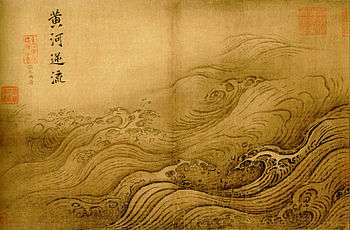Huaxia
| Huaxia | |||||||||||||||||||||||||||||
|
The Yellow River Breaches its Course by Ma Yuan, Song dynasty | |||||||||||||||||||||||||||||
| Traditional Chinese | 華夏 | ||||||||||||||||||||||||||||
|---|---|---|---|---|---|---|---|---|---|---|---|---|---|---|---|---|---|---|---|---|---|---|---|---|---|---|---|---|---|
| Simplified Chinese | 华夏 | ||||||||||||||||||||||||||||
| |||||||||||||||||||||||||||||
| Part of a series on |
| Names of China |
|---|
Huaxia is a historical concept representing the Chinese nation and civilization. It came forth out of a self-awareness of the Han Chinese people towards their ancestral tribes, collectively known as the Huaxia.
Etymology
According to the Zuo Zhuan, xia (夏)—which has the meaning of "grand"—was used to signify the ceremonial etiquette of China, while hua (華)—as it means "illustrious"—was used in reference to the beautiful clothing that the Chinese people wore (中國有禮儀之大,故稱夏;有服章之美,謂之華).[1]
History
Origin
In the original sense, Huaxia refers to a confederation of tribes—living along the Yellow River—who were the ancestors of what later became the Han ethnic group in China.[2][3] During the Warring States (475–221 BCE), the self-awareness of the Huaxia identity developed and took hold in ancient China.[3][4] Initially, Huaxia defined mainly a civilized society that was distinct and stood in contrast to what was perceived as the barbaric peoples around them.[5]
Modern usage
Although still used in conjunction, the Chinese characters for Hua and Xia are also used separately as autonyms.
The official Chinese names of both the People's Republic of China (PRC) and the Republic of China (ROC) use the term Huaxia in combination with the term Zhongguo (中国; 中國, translated as "Middle Kingdom"), that is, as Zhonghua (中华; 中華).[5] The PRC's official Chinese name is Zhonghua Renmin Gongheguo (中华人民共和国), while that of the ROC is Zhonghua Minguo (中華民國). Today, the term Zhongguo usually refers to the nation itself and Zhonghua to the civilization.
Chinese people commonly call themselves "Hua people" (华人; 華人; Huaren).[6]. Several Southeast Asian countries call Mandarin Chinese "Hua language" (华语; 華語; Huáyǔ)
See also
- Yan Huang Zisun, literally "descendants of Yan and Huang"
- Hua–Yi distinction
- Nine Provinces
- Zhonghua (disambiguation)
Notes
- ↑ Liu 2005, p. 9
- ↑ Cioffi-Revilla & Lai 1995, pp. 471–72.
- 1 2 Selin 1997, p. 197.
- ↑ Guo & Feng 1997, p. 197.
- 1 2 Holcombe 2010, p. 7.
- ↑ Solé-Farràs 2013, p. 93.
References
- Cioffi-Revilla, Claudio; Lai, David (1995). "War and Politics in Ancient China, 2700 BC to 722 BC". The Journal of Conflict Resolution. 39 (3).
- Guo, Shirong; Feng, Lisheng (1997). "Chinese minorities". Encyclopaedia of the history of science, technology, and medicine in non-western cultures. Dordrecht: Kluwer. ISBN 978-0-7923-4066-9.
- Holcombe, Charles (2010). A history of East Asia: From the origins of civilization to the twenty-first century. Cambridge: Cambridge University Press. ISBN 978-0-521-73164-5.
- Liu, Xuediao [劉學銚] (2005). 中國文化史講稿 (in Chinese). Taipei: 知書房出版集團. ISBN 978-986-7640-65-9.
- Selin, Helaine (1997). Encyclopaedia of the history of science, technology and medicine in non-western cultures. Dordrecht: Kluwer. ISBN 978-0-79234066-9.
- Solé-Farràs, Jesús (2013). New Confucianism in twenty-first century China: The construction of a discourse. London: Routledge. ISBN 978-1-13473908-0.
